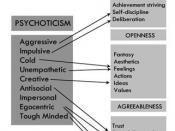The precise definition of personality has been a point of discussion amongst many different
theorists within many different disciplines since the beginning of civilisation. Personality can be
defined as 'the distinctive and characteristic patterns of thought, emotion, and behaviour that define
an individual's personal style and influence his or her interactions with the environment' (Atkinson,
Atkinson, Smith & Bem, 1993: 525). It can be proposed that personality psychology has two
different tasks. 'The first involves specifying the variables on which individuals differ from one
another. The second involves synthesising the psychological processes of human functioning into an
integrated account of the total person' (Atkinson et al., 1993: 532). There are many different theories
of personality and many different theorists. The purpose of this essay is to examine the trait approach,
specifically the five-factor model. Both the development and limitations of the Five-Factor model of
personality shall be discussed.
Trait theory is based on several assumptions.
The first assumption is that any difference
between people that is seen as significant will have a name. Secondly, these names, known as traits,
are conceived of as continuous dimensions. In general, trait theories assume that people vary
simultaneously on a number of personality factors. These traits are of both the conjunctive and
disjunctive form. Therefore, to understand a trait, it is necessary to understand what a particular trait
is and what type of behaviour is evidence of that trait. (Atkinson et al., 1993). Five factor theorists are
one set of trait theorists. The claim of five factor theorists is that behaviour can be best predicted and
explained by measurement of five dominant personality factors. The five factor theory is a fairly
recent proposal and has its basis in earlier work, which shall be discussed.
One of the statistical techniques most commonly used in the...


